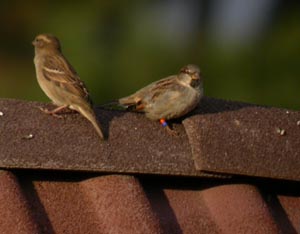

Social and genetic relationships
 Sparrows
are highly gregarious, especially in the non-breeding season when they live
in flocks. Although sparrows are quite sedentary, remainig within a few kms
of their nesting colony, little is known of their social organization. Are
wintering flocks stable in their composition? Are the movements of birds among
flocking centers just random, or do certain individuals preferentially associate
with one another? Do the genetic relationships among individuals influence
their social behaviours?
Sparrows
are highly gregarious, especially in the non-breeding season when they live
in flocks. Although sparrows are quite sedentary, remainig within a few kms
of their nesting colony, little is known of their social organization. Are
wintering flocks stable in their composition? Are the movements of birds among
flocking centers just random, or do certain individuals preferentially associate
with one another? Do the genetic relationships among individuals influence
their social behaviours?
We investigate the social structure of wintering sparrow flocks by marking a large number of birds individually using colour rings and then by tracking their movements and associations among flocks at several feeding and roosting sites by field observations and recaptures. We also investigate the effect of genetic relatedness on the organization of social groups and on the interactions of individuals including their aggressive, associative and 'scrounging' (see Social foraging) behaviours towards their differentially related flockmates. We estimate the degree of relatedness among individuals using microsatellite DNA markers of polymorhic loci.